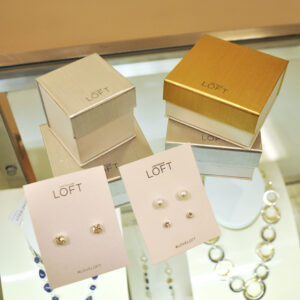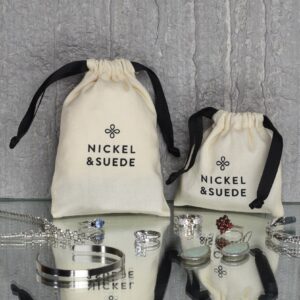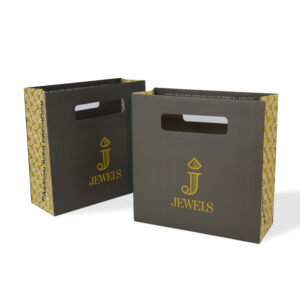









The presentation of a product is just as crucial as the product itself. This is particularly true in the jewelry industry where first impressions either enchant or disengage potential customers. Branded jewelry packaging serves not just as a protective vessel for precious items, but as an extension of the brand identity and a crucial instrument in the marketing symphony. From luxury boxes to suede pouches, the choice of packaging material and design speaks volumes about the jewelry’s care, quality, and exclusivity.
The Importance of Jewelry Packaging in Retail
The role of packaging extends far beyond merely housing a product. This significance is underscored by various packaging elements; including color, material, and design. Each of these components plays a crucial role in attracting consumer attention. Furthermore, enhancing the product’s appearance and shaping the consumer’s perception of the brand are essential for building a strong brand image.
Variables Influencing Consumer Behavior
- Trending Color Palettes: The first element often noticed. Color evokes emotion and association.
- Imagery: Sets the tone and context for the product, enhancing its appeal.
- Materials: Conveys quality. Impacts brand perception.
- Typography: Influences readability and brand personality.
- Overall Design: Stand out from the competition on a crowded shelf.
- Printed Information: Offers essential product details and brand story.
- Innovation: Unique packaging solutions set a brand apart and engage customers.
Decision-Making in the Store
It’s estimated that up to 70% of buying decisions occur in-store, where consumers are overwhelmed with choices. Many factors influence purchase decisions, including brand familiarity, product perceptions shaped by packaging design, and personal factors such as lifestyle and cultural background. An attractive and informative packaging design sways consumers towards a particular brand. Additionally, packaging is a critical component of the marketing strategy.
Direct Communication with Consumers
With the intense competition across different industries, packaging has evolved into a direct communication channel with consumers. Elements like color, images, and typography not only catch the eye but also effectively communicate the brand’s message and values. This direct communication is essential for influencing purchase decisions and building a connection with consumers.
Impact on Brand Recognition and Loyalty
Quality packaging not only reflects the brand’s image but also has the power to forge a stronger emotional connection with consumers. The first impression packaging creates greatly impacts brand recognition and loyalty. What’s more, the unboxing experience. Facilitated by thoughtful packaging, a lasting impression is left with customers, further enhancing brand loyalty.
Product Shelf Appeal and Sustainability
The uniqueness of packaging in terms of texture, color, and shape contributes significantly to its shelf appeal. In an era where environmental consciousness is on the rise, the sustainability of packaging materials also plays a crucial role in attracting eco-conscious consumers. By using responsibly sourced papers, for example, brands enhance their story and appeal to a broader audience.
The importance of jewelry packaging in retail cannot be overstated. It serves as a crucial factor in decision-making, brand recognition, and fostering customer loyalty. As such, jewelry businesses must pay close attention to their packaging design to ensure it aligns with their brand identity and stands out in the competitive market.
Types of Branded Jewelry Packaging
The way a product is packaged greatly affects its appeal and perceived value. This is particularly true for jewelry; where packaging goes beyond protection to include presentation and brand storytelling. Branded luxury jewelry packaging comes in various forms, each designed to enhance the customer’s experience. All while reinforcing the brand’s identity. Here, we delve into the main types of branded jewelry packaging.
Boxes
Jewelry boxes are the cornerstone of branded packaging. Offering both protection and a premium presentation. They are available in a myriad of materials, including greyboard and fabrics. The design of these boxes can vary and further reflect the brand’s image and product’s style. Notable designs include:
- Metallic Foil Boxes: These feature cardstock accented with metallic foil for a luxurious look.
- Custom Rigid Boxes: A popular choice with multiple constructions to choose from.
- Embossed Print Boxes: Ideal for high-end jewelry pieces, adding texture and depth to the branding.
- Boxes with Printed Ribbons: Simple yet sophisticated, adding a touch of detail to the packaging.
These boxes not only serve as protective packaging but also as a canvas for brand expression through custom printing, treatments, and the use of unique materials.
Pouches
Jewelry pouches offer a versatile and practical solution for jewelry packaging. They are crafted from various fabrics such as cotton, PP non-woven (PPNW), velvet, organza, or linen. Offering a soft enclosure for jewelry items. Pouch styles include:
- Fold-Over Pouches: Featuring a fold-over closure for a decorative touch.
- Round-bottom Pouches: Offering a unique shape for a distinctive presentation.
- Drawstring Pouches: The most popular design with a pull-top closure.
- Zip Pouches: Ensuring durability with a stylish zipper closure.
Jewelry pouches are not just functional but also contribute to the brand’s narrative through customization options like material, construction, and closures. They are perfect for creating a memorable unboxing experience while ensuring the safety of the jewelry.
Custom Inserts
Custom inserts play a crucial role in jewelry packaging by providing added protection and a tailored fit for each piece. They can be made from various materials, including foam, fabric, or paper, depending on the level of cushioning and support needed. Some of these inserts include.
- Earring Cards: Adding a personal touch to the packaging collection enhances the overall experience.
- Jewelry Box Inserts: Keeps jewelry safe while offering a unique presentation.
The benefits of using custom inserts include cost efficiency, customizability, enhanced protection, and the opportunity for direct communication with customers. Inserts also enhance the unboxing experience, creating a brand story that resonates with the consumer.
The variety of branded jewelry packaging options available allows brands to select the perfect packaging solution that aligns with their aesthetic, functional needs, and sustainability goals. From luxurious boxes to practical pouches and customizable inserts, each packaging type offers unique benefits and opportunities for brand expression and customer engagement.
Material Selection for Packaging
Selecting the right materials for jewelry packaging is crucial. As it directly influences the brand’s image, sustainability goals, and customer satisfaction. This section explores many options like luxurious materials and cost-effective solutions for creating impactful jewelry packaging.
Luxurious Materials
For brands aiming to exude sophistication and luxury, the choice of packaging material is paramount. Exquisite jewelry packaging often utilizes elegant materials and treatments such as plush velvet, coated art papers, and unique treatments. Resulting in a luxurious unwrapping experience. The use of matte lamination or foil hot stamping further adds a touch of luxury to the packaging. High-end brands also favor luxury papers and boards for their durability and luxurious feel. These materials, combined with custom branding and unique finishes, transform the package into a piece of art. Captivating customers before they even see the jewelry inside.
Design Considerations for Effective Packaging
When approaching the design of effective jewelry packaging, several critical considerations come into play. The considerations aim to protect the jewelry, enhance the brand’s identity, connect emotionally with customers, and ensure practical packaging for both consumers and retailers.
Branding Elements
Effective branding in packaging hinges on the consistent placement of logos and the use of brand colors. This visual consistency is crucial as it aids customers in quickly identifying the brand across various products. Incorporating storytelling elements into the packaging design significantly enhances this connection.
Color and Visual Appeal
The selection of colors and the overall visual appeal of the packaging are not to be underestimated. They play a significant role in attracting consumer attention and shaping their perception of the brand. Brands may opt for metal tins, solid-colored packages, or eco-friendly materials that not only protect the jewelry but also enhance the brand’s premium appearance and commitment to sustainability. The choice between minimalist designs or decorative boxes with bold patterns should reflect the brand’s identity, ensuring that the packaging aligns with the brand’s aesthetic values.
Functional Design
Practicality is equally important in the design of jewelry packaging. The packaging must be functional, effectively protecting items like necklaces and earrings while remaining easy to handle. Choosing the right materials is key to balancing aesthetics with durability. Designing effective jewelry packaging requires a thoughtful balance of branding elements, visual appeal, and functional design. By focusing on these key areas, brands can create packaging that not only protects the jewelry but also enhances the customer’s unboxing experience, fostering a stronger connection with the brand.
Trends in Jewelry Packaging
The landscape of jewelry packaging is constantly evolving, with brands striving to create designs that not only protect but also enhance the value of their products. As consumer expectations shift towards more personalized and sustainable options, the industry is seeing a surge in innovative packaging solutions. Here, we explore some of the latest trends in jewelry packaging, focusing on multi-purpose packaging, engagement ring packaging, and innovative designs.
Multi-Purpose Packaging
One of the most notable trends is the development of packaging that serves multiple functions beyond simply housing jewelry. These versatile solutions include reusable boxes that double as travel cases or elegant storage for the home. This approach not only enhances the perceived value of the jewelry but also fosters a long-term relationship between the brand and the consumer. By offering packaging that continues to be useful long after the initial purchase, brands can significantly enhance customer satisfaction and loyalty.
Engagement Ring Packaging
Engagement rings, symbolizing a significant life milestone, deserve packaging that is as special as the occasion they commemorate. The focus has shifted towards compact and elegant packaging that not only safeguards precious items but also elevates the unboxing experience to a memorable event. Velvet linings and cushioned inserts are used to showcase the ring in a luxurious setting, transforming the act of opening the box into a cherished moment. This attention to detail in packaging reflects the importance of the engagement ring and adds to the overall emotional impact of the proposal.
Final Thoughts
In conclusion, the tailored strategies for engaging different customer demographics with thoughtful design considerations reflect a keen understanding of the market’s evolving demands. This focus on personalization, coupled with an unwavering commitment to sustainability, illustrates how jewelry packaging can be both beautiful and environmentally responsible. As retailers consider the important intersection between aesthetics and functionality in packaging, the call to action is clear: investing in quality, branded packaging is indispensable. By embracing innovative designs and sustainable materials, brands can craft memorable experiences that resonate with consumers, setting the stage for enduring success in the competitive landscape of retail jewelry.



